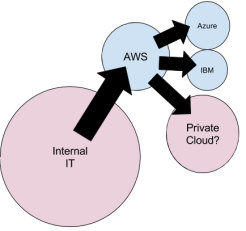Joining us this week is Ian Rae, CEO and Founder CloudOps who recorded the podcast during the Google Next conference in 2018.

Highlights
- 1 min 55 sec: Define Cloud from a CloudOps perspective
- Business Model and an Operations Model
- 3 min 59 sec: Update from Google Next 2018 event
- Google is the “Engineer’s Cloud”
- Google’s approach vs Amazon approach in feature design/release
- 9 min 55 sec: Early Amazon ~ no easy button
- Amazon educated the market as industry leader
- 12 min04 sec: What is the state of Hybrid? Do we need it?
- Complexity of systems leads to private, public as well as multiple cloud providers
- Open source enabled workloads to run on various clouds even if the cloud was not designed to support a type of workload
- Google’s strategy is around open source in the cloud
- 14 min 12 sec: IBM visibility in open source and cloud market
- Didn’t build cloud services (e.g. open a ticket to remap a VLAN)
- 16 min 40 sec: OpenStack tied to compete on service components
- Couldn’t compete without Product Managers to guide developers
- Missed last mile between technology and customer
- Didn’t want to take on the operational aspects of the customer
- 19 min 31 sec: Is innovation driven from listening to customers vs developers doing what they think is best?
- OpenStack is seen as legacy as customers look for Cloud Native Infrastructure
- OpenStack vs Kubernetes install time significance
- 22 min 44 sec: Google announcement of GKE for on-premises infrastructure
- Not really On-premise; more like Platform9 for OpenStack
- GKE solve end user experience and operational challenges to deliver it
- 26 min 07 sec: Edge IT replaces what is On-Premises IT
- Bullish on the future with Edge computing
- 27 min 27 sec: Who delivers control plane for edge?
- Recommends Open Source in control plan
- 28 min 29 sec: Current tech hides the infrastructure problems
- Someone still has to deal with the physical hardware
- 30 min 53 sec: Commercial driver for rapid Edge adoption
- 32 min 20 sec: CloudOps building software / next generation of BSS or OSS for telco
- Meet the needs of the cloud provider for flexibility in generating services with the ability to change the service backend provider
- Amazon is the new Win32
- 38 min 07 sec: Can customers install their own software? Will people buy software anymore?
- Compare payment models from Salesforce and Slack
- Google allowing customers to run their technology themselves of allow Google to manage it for you
- 40 min 43 sec: Wrap-Up
Podcast Guest: Ian Rae, CEO and Founder CloudOps
Ian Rae is the founder and CEO of CloudOps, a cloud computing consulting firm that provides multi-cloud solutions for software companies, enterprises and telecommunications providers. Ian is also the founder of cloud.ca, a Canadian cloud infrastructure as a service (IaaS) focused on data residency, privacy and security requirements. He is a partner at Year One Labs, a lean startup incubator, and is the founder of the Centre cloud.ca in Montreal. Prior to clouds, Ian was responsible for engineering at Coradiant, a leader in application performance management.









 Here’s the summary:
Here’s the summary: